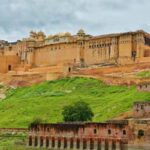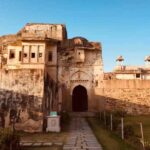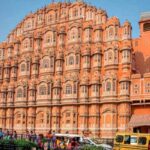10 Best Historical Places in Jaipur, the capital city of Rajasthan, India, boasts a plethora of captivating historical sites that chronicle its rich heritage and architectural grandeur. The iconic Hawa Mahal, often referred to as the “Palace of Winds,” stands as a testament to the city’s unique architectural marvels, featuring a facade adorned with 953 intricately designed windows.
The opulent City Palace showcases a blend of Rajput and Mughal influences, encompassing exquisite palaces, courtyards, and museums. Equally captivating is the majestic Amber Fort, situated atop a hill, offering panoramic views and showcasing the grandeur of Rajput architecture through its stunning palaces, halls, and courtyards.
The Jantar Mantar, a UNESCO World Heritage site, is an astronomical observatory that exhibits the scientific prowess of Maharaja Sawai Jai Singh II. This site features a collection of ingenious instruments designed for celestial observations.
Perched on the Aravalli Hills, the Nahargarh Fort not only provides breathtaking vistas but also narrates tales of defense and retreat. The Jaigarh Fort, known for its massive cannon Jaivana, offers an insight into the military history of the region Jaipur Tour Packages.
Within the heart of the city lies the Albert Hall Museum, Rajasthan’s oldest museum, exhibiting an array of artistic treasures from around the world. Meanwhile, the Galtaji Temple holds spiritual significance and features natural springs and temples amidst a stunning landscape.
The Sisodia Rani Garden enchants visitors with its romantic allure, adorned with terraced gardens, fountains, and captivating frescoes narrating tales of Radha-Krishna. For architectural enthusiasts, the village of Abhaneri, near Jaipur, houses the mesmerizing Chand Baori, an intricate stepwell with 3,500 symmetrically arranged steps.
In summary, Jaipur is a treasure trove of historical gems that encompass architectural brilliance, cultural heritage, and a profound sense of history, making it a must-visit destination for anyone seeking to immerse themselves in India’s past Jaipur Tour Planner.
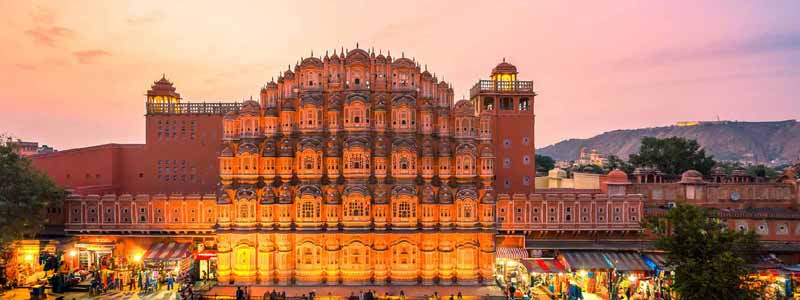
Hawa Mahal:
Hawa Mahal, located in Jaipur, Rajasthan, is a captivating architectural marvel that stands as a testament to the city’s rich history. Translating to the “Palace of Winds,” it was constructed in 1799 by Maharaja Sawai Pratap Singh. This distinctive five-story structure boasts a stunning façade adorned with 953 small lattice windows, known as jharokhas, intricately designed to resemble a honeycomb.
The purpose behind Hawa Mahal’s construction was to provide a private vantage point for royal women to observe the bustling street life and festivities of the city without compromising their seclusion. This innovative architectural approach allowed cool breezes to flow through the jharokhas, keeping the palace well-ventilated, especially during Rajasthan’s scorching summers.
Hawa Mahal’s pink and red sandstone façade, characteristic of Jaipur’s architectural style, adds to its allure and significance as an iconic landmark. Over the years, this historical treasure has captured the imagination of travelers and history enthusiasts alike, offering a glimpse into the opulent lifestyles of the past and standing as a testament to the artistic brilliance of its time Jaipur Attractions.
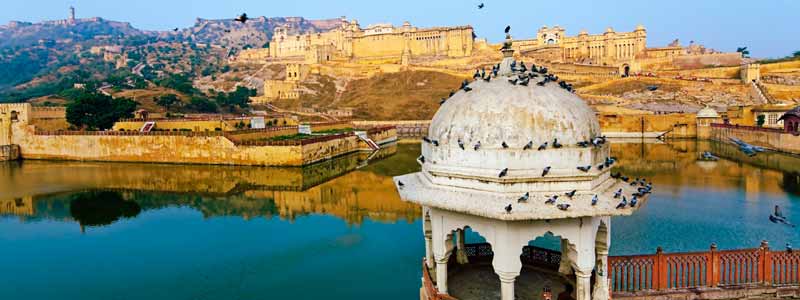
Amber Fort:
Amber Fort, also known as Amer Fort, is a majestic and historic fortress located in Jaipur, Rajasthan, India. Perched atop a hill and overlooking the Maota Lake, the fort is a stunning blend of Rajput and Mughal architectural styles. It was built by Raja Man Singh I in the late 16th century and later expanded by successive rulers Jaipur Tourism.
The fort’s impressive entrance, known as the Suraj Pol (Sun Gate), leads to a series of courtyards, palaces, and intricate structures. Notable attractions within the fort include the Diwan-i-Aam (Hall of Public Audience), Diwan-i-Khas (Hall of Private Audience), Sheesh Mahal (Mirror Palace), Sukh Niwas (Pleasure Palace), and the Ganesh Pol, a beautifully decorated gateway.
One of the most renowned features of Amber Fort is the Sheesh Mahal, a chamber adorned with intricate mirror work that creates a dazzling effect when light reflects off its surfaces. The fort also offers breathtaking panoramic views of the surrounding landscape, making it a popular destination for both history enthusiasts and tourists.
Visitors often choose to reach the fort by either walking, taking an elephant ride, or using modern transport options. Amber Fort stands as a testament to Rajasthan’s rich cultural heritage, its historical significance, and the architectural ingenuity of the time, making it an essential part of any visit to Jaipur.
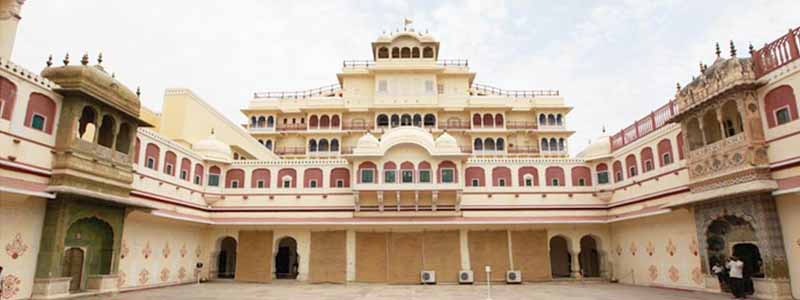
City Palace:
The City Palace in Jaipur, Rajasthan, is a grand and opulent complex that reflects the rich history and architectural splendor of the region. Built in the 18th century by Maharaja Sawai Jai Singh II, the palace is a captivating fusion of Rajput and Mughal architectural styles.
Comprising a series of courtyards, gardens, and palaces, the City Palace showcases the lifestyle of the Rajput royals. The Chandra Mahal and Mubarak Mahal are prominent structures within the palace complex. Chandra Mahal, the seven-story palace, was the residence of the royal family and now houses a museum displaying a collection of artifacts, textiles, and art pieces. Mubarak Mahal, known as the “Welcome Palace,” features an exquisite blend of Islamic, Rajput, and European architectural elements.
The intricately designed gateways, ornate facades, and delicate marble carvings contribute to the palace’s magnificence. The palace complex also provides insights into the Maharaja’s court, with Diwan-i-Aam (Hall of Public Audience) and Diwan-i-Khas (Hall of Private Audience) showcasing their respective functions Jaipur Private Day Tours.
A visit to the City Palace offers a journey into Rajasthan’s royal heritage, allowing visitors to immerse themselves in the grandeur of its architecture and the stories of its regal past.
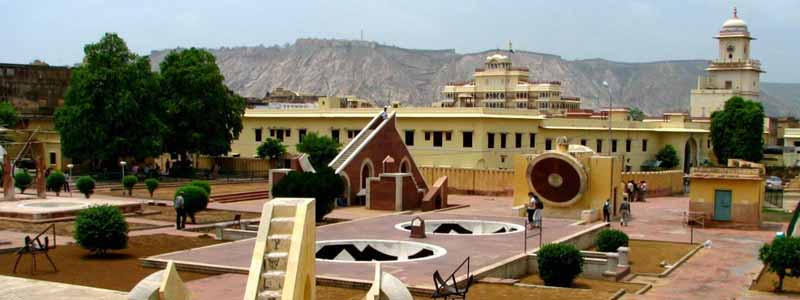
Jantar Mantar:
Jantar Mantar, a UNESCO World Heritage site located in Jaipur, Rajasthan, is a remarkable testament to the scientific and astronomical prowess of Maharaja Sawai Jai Singh II. Constructed in the early 18th century, Jantar Mantar is an astronomical observatory consisting of a collection of large and ingenious instruments designed to observe and measure celestial phenomena with remarkable precision.
The site’s instruments include sundials, astronomical clocks, and celestial measuring tools. One of the most notable instruments is the Samrat Yantra, the world’s largest sundial, which can accurately measure time down to two-second intervals. The Jai Prakash Yantra comprises two hemispherical bowls with markings that determine the position of the sun and other celestial bodies.
The instruments are not only awe-inspiring in their scale but also in their functional complexity. These instruments were used by Jai Singh II and his astronomers to track celestial events, predict eclipses, and make precise calculations related to time and space.
Jantar Mantar’s architecture is a fusion of scientific ingenuity and artistic craftsmanship. The instruments are strategically positioned, aligned with the cardinal directions, and designed to be user-friendly for astronomers of the time.
Visiting Jantar Mantar provides a unique opportunity to appreciate the scientific advancements of ancient India and the extraordinary vision of Maharaja Sawai Jai Singh II. The site serves as a bridge between astronomy, architecture, and cultural heritage, offering visitors a chance to explore the intersection of science and history while marveling at the intellect of the past.
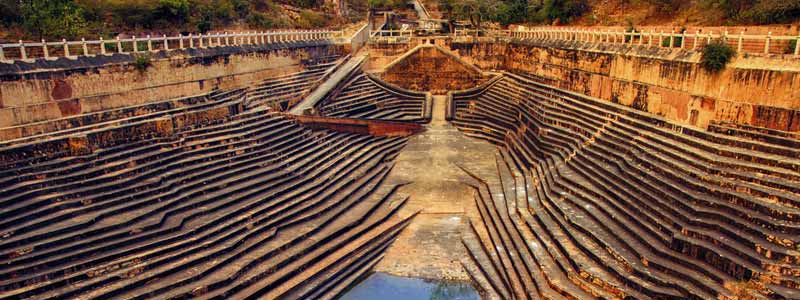
Nahargarh Fort:
Perched on the rugged Aravalli Hills overlooking Jaipur, Nahargarh Fort is a historic stronghold that offers stunning panoramic views of the city’s landscape. Built in 1734 by Maharaja Sawai Jai Singh II, this fort served as a retreat and defense structure in the past.
Nahargarh Fort’s name is believed to be derived from the legend of a spirit named Nahar Singh, who was believed to haunt the site before the fort’s construction. The fort’s architecture combines both Indian and European influences, reflecting the evolving architectural trends of the time.
The fort is known for its well-preserved structures, including royal apartments, courtyards, and observation points that provide breathtaking vistas of Jaipur’s urban sprawl. The Madhavendra Bhawan, a two-story palace within the fort, was used by the king to accommodate his queens.
Nahargarh Fort played a significant role in history, as it was one of the defensive structures guarding Jaipur from potential threats. Today, it stands as a captivating historical attraction, offering a blend of history, architecture, and stunning views that attract tourists and locals alike. Whether it’s to delve into the past or to witness the sun setting over the city, Nahargarh Fort remains a must-visit destination in Jaipur.
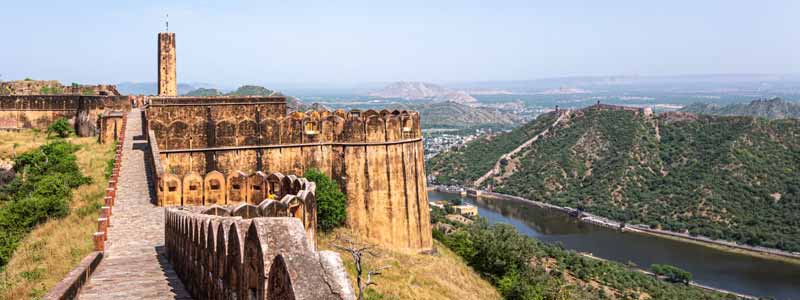
Jaigarh Fort:
Jaigarh Fort, situated on the rugged hills above Amber Fort in Jaipur, Rajasthan, is a formidable historical marvel that reflects the military prowess and architectural grandeur of its time. Built in 1726 by Maharaja Sawai Jai Singh II, this majestic fort was designed to serve as a defensive stronghold and to safeguard the Amber Fort and the city of Jaipur.
One of the fort’s most notable features is the Jaivana Cannon, which holds the distinction of being one of the world’s largest wheeled cannons. The fort’s strategic location and strong defensive structures emphasize its role in safeguarding the Amber region.
Jaigarh Fort’s architectural design is a harmonious blend of defensive elements and opulent palace structures. The fort encompasses wide ramparts, watchtowers, reservoirs, and a magnificent palace complex that includes residential areas, courtyards, and gardens. The fort’s beauty lies in its austere yet elegant design, which highlights the might of the Rajput rulers while offering a glimpse into their regal lifestyles.
Beyond its defensive significance, Jaigarh Fort also offers captivating panoramic views of the surrounding landscapes, including Amber Fort and the scenic Aravalli hills. The fort’s historical relevance, coupled with its architectural brilliance, makes it a must-visit destination for history enthusiasts, photographers, and travelers seeking to delve into the rich heritage of Rajasthan.
As a window into the past, Jaigarh Fort stands as a monument to Rajasthan’s history, showcasing the fusion of military strategies and architectural finesse while narrating tales of valor and royal legacy.
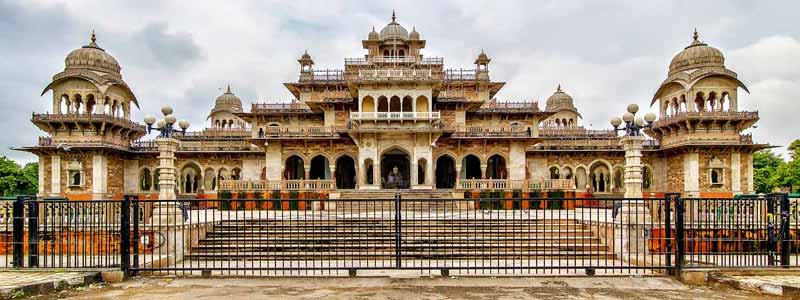
Albert Hall Museum:
The Albert Hall Museum, located in Jaipur, Rajasthan, is a significant cultural and historical institution that showcases the region’s artistic and historical heritage. Built in 1876 to commemorate the visit of Prince Albert (the consort of Queen Victoria), the museum is a prime example of Indo-Saracenic architecture, blending Indian and European architectural styles.
The museum’s splendid façade features intricate carvings, domes, and arches that reflect the fusion of Rajput, Mughal, and European influences. The central dome is particularly noteworthy, adorned with delicate patterns and ornate detailing.
Inside, the Albert Hall Museum houses a diverse collection of artifacts, including sculptures, paintings, decorative arts, textiles, pottery, and more. The galleries display items ranging from ancient to contemporary periods, offering visitors insights into Rajasthan’s history, culture, and artistic evolution.
One of the museum’s highlights is the Egyptian mummy, a rare exhibit that draws considerable attention. The museum also hosts temporary exhibitions and cultural events that contribute to the vibrant cultural scene of Jaipur.
Visiting the Albert Hall Museum provides a captivating journey through time, offering a comprehensive understanding of Rajasthan’s rich artistic and cultural heritage. The museum’s architectural splendor and extensive collection make it a must-see destination for art enthusiasts, history buffs, and anyone seeking to explore the multifaceted essence of Jaipur’s past and present.
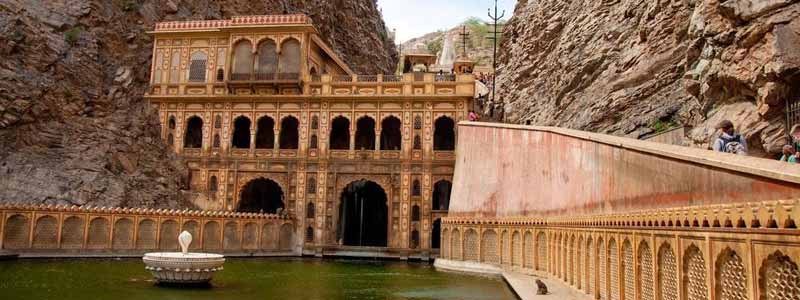
Galtaji Temple:
The Galtaji Temple, affectionately known as the Monkey Temple, is a unique and sacred pilgrimage site situated in the Aravalli hills on the outskirts of Jaipur, Rajasthan. This historic temple complex comprises a series of temples, pavilions, natural springs, and water tanks that hold cultural and religious significance.
The temple is dedicated to Lord Hanuman, the revered monkey god in Hindu mythology, and is a place of devotion and worship. The name “Monkey Temple” is derived from the playful presence of a large population of monkeys that inhabit the area, adding to the temple’s distinctive charm.
Galtaji Temple’s architecture is characterized by pink sandstone and intricate designs that blend seamlessly with the natural surroundings. The main temple, known as the Galtaji Temple, features stunning pillars, domes, and carvings that showcase the craftsmanship of the era.
The temple complex also houses several kunds (water tanks) that are believed to possess spiritual and purifying properties. The most famous among them is the Galta Kund, which is fed by a natural spring and remains filled with water throughout the year 10 Best Historical Places in Jaipur.
Galtaji Temple’s serene ambiance, lush landscape, and cultural significance attract both devotees and tourists. The complex is not only a religious site but also a place where visitors can immerse themselves in the spiritual atmosphere and witness the coexistence of nature and devotion. Exploring Galtaji Temple offers an enriching experience that highlights the diverse facets of Jaipur’s cultural tapestry.
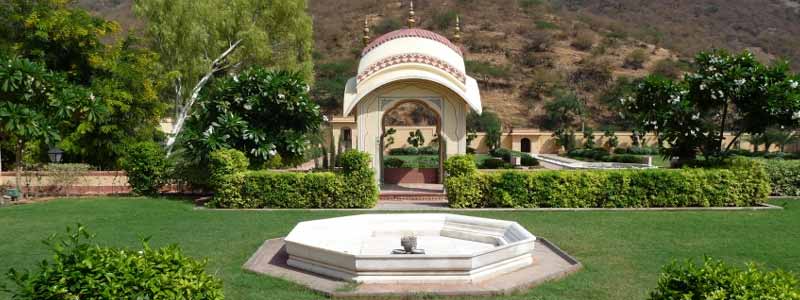
Sisodia Rani Garden:
The Sisodia Rani Garden, situated on the outskirts of Jaipur in Rajasthan, is a picturesque garden that encapsulates the romance and artistic beauty of the region. Built by Maharaja Sawai Jai Singh II in 1728 for his queen, Sisodia Rani, the garden is a serene retreat adorned with lush greenery, cascading fountains, and ornate pavilions 10 Best Historical Places in Jaipur.
The garden is designed in a Mughal style, featuring terraced layouts, intricate frescoes, and beautifully landscaped paths. The frescoes narrate the tale of Radha-Krishna, evoking a sense of love and devotion in their vibrant and detailed depictions. The garden’s architecture and design reflect a fusion of Mughal and Rajput influences, creating a tranquil oasis that serves as a testament to the artistic brilliance of the time.
Sisodia Rani Garden’s layout includes various levels, each with its own charm. The central pavilion offers panoramic views of the surroundings, while the fountains and water channels enhance the soothing ambiance. The garden’s terraced patterns and symmetrical structures add to its visual appeal.
The garden provides a serene escape from the bustling city and allows visitors to immerse themselves in the romanticism and artistic legacy of Rajasthan. Sisodia Rani Garden stands as a symbol of love, creativity, and the harmonious integration of nature and art, making it a captivating destination for those seeking a tranquil and culturally enriching experience in Jaipur.
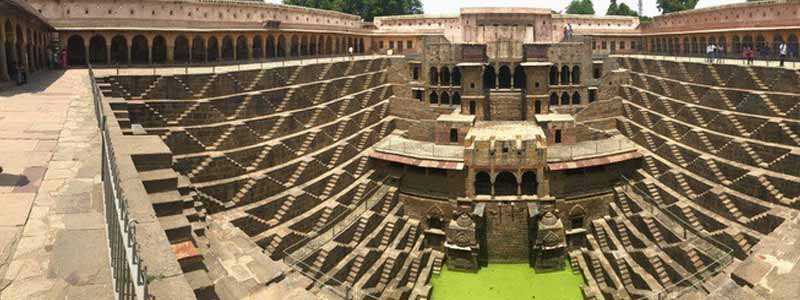
Chand Baori:
Chand Baori, located in the village of Abhaneri near Jaipur, Rajasthan, is a magnificent stepwell that showcases the ingenuity and architectural prowess of ancient India. Built in the 9th century by King Chanda of the Nikumbha Dynasty, Chand Baori is one of the deepest and largest stepwells in the world.
The stepwell is a mesmerizing geometric marvel, consisting of a series of symmetrical steps that descend dramatically into the ground, forming a square structure. With 3,500 narrow steps spread over 13 stories, Chand Baori served multiple purposes, including providing a reliable source of water during dry seasons, as well as being a place for community gatherings and spiritual rituals.
What makes Chand Baori particularly captivating is its intricate and precisely designed structure. The steps are flanked by ornate carvings, archways, and pillared pavilions that exemplify the exquisite craftsmanship of the time. The stepwell’s depth, combined with its architectural beauty, creates a mesmerizing play of light and shadow 10 Best Historical Places in Jaipur.
Chand Baori’s historical and architectural significance, coupled with its dramatic visual impact, make it a popular destination for travelers, photographers, and history enthusiasts. The stepwell’s sheer magnitude and the complexity of its design stand as a testament to the advanced engineering and artistic sensibilities of ancient India, providing a unique window into the region’s rich heritage.





